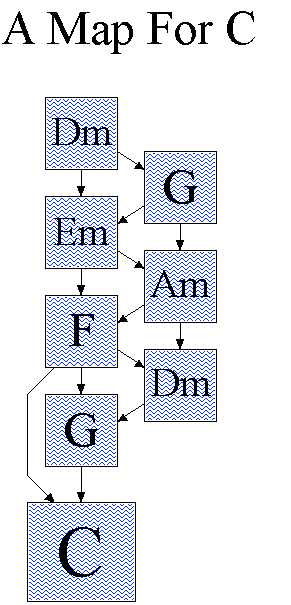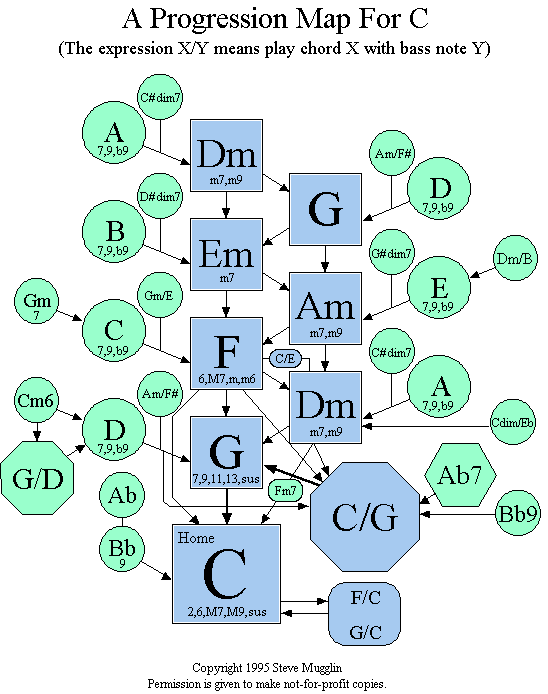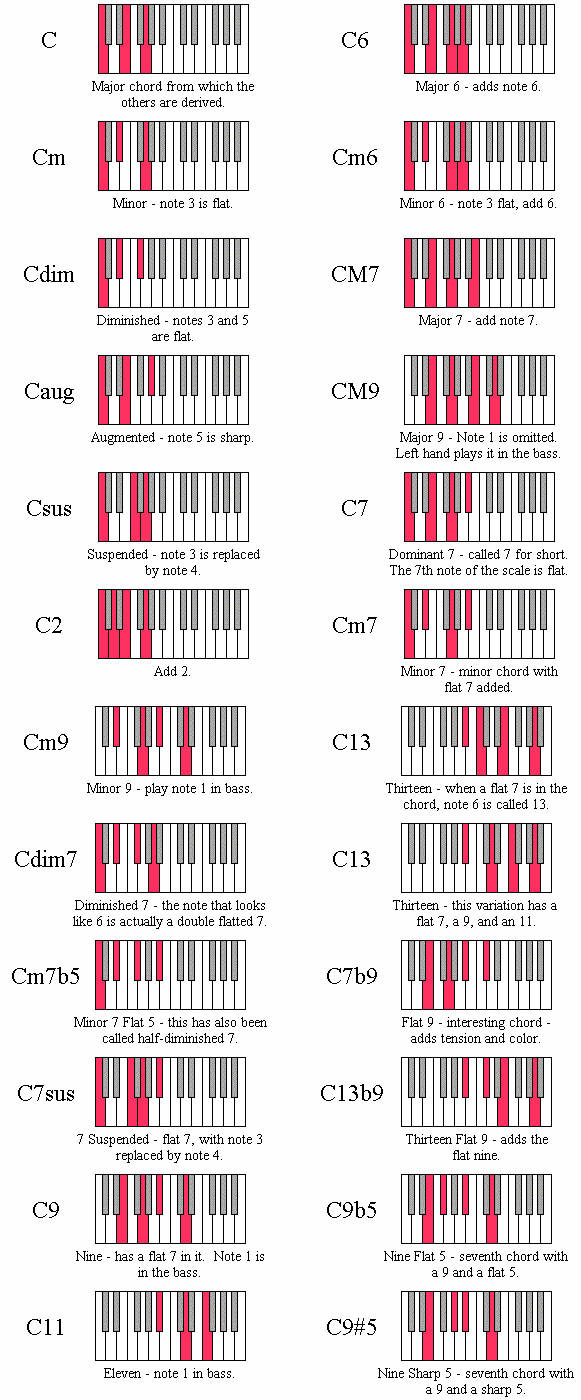
| Pages | 1 | 2 | 3 | 4 |
There are a whole group of chords with wild names like nines, elevens, thirteens, nine sharp fives,
nine flat fives, and the list goes on. These chords have very interesting sounds. A good player will
use these chords when that particular sound is needed. Often the player "substitutes" one of these
complex chords for a simpler one in the music. Suppose the music calls for an A7. An A7b9 might
sound even better. That's why we call them chord substitutions. You can use them in place of
simpler chords you already know. Here are some substitutes for A7.
|
The A7b9 looks like this.
|
 |
|
Another substitute for A7 is G/A.
|
 |
This topic is addressed in Part Five. Before going there, it might be good to step back and see
where we've been.
Let's Review
In this part, we saw the number of chords available to us suddenly explode. We learned that even
simple chords can be played in several ways called inversions. Slash chords were introduced to
keep track of bass notes when the bass is playing something other than the root. We used scale
notes to get chords like 2, 6, M7, sus. We used non-scale notes to get iv and iim7b5. Chord
substitutions like nines, elevens, and thirteens came along to replace sevens when needed.
Chords From Other Keys
Secondary Chords. These are chords borrowed from other keys. Let's explain it this way.
Have you ever visited a Water Park with pools and slides? Let's take our Simple Map and use
our imagination. First, I'm going to change the simple map from I, ii, iii, IV, V, vi to C, Dm, Em,
F, G, and Am. These are the chords for the key of C. Second, I'm going to make each square in
the diagram a "pool" in our imaginary Water Park. Got it?

But this time we add a new rule. At any time you may leave the water to come down a slide. Where are the slides? Here they are!

Okay... we have a few things to talk about.
1. First, let's talk about the blue boxes. Some of the chord variations now appear at the
bottom of each box. For instance, C lists the 2 chord, the 6 chord, major 7, major 9, and
suspended as possible options.
2. Three blue locations have been added. The octagon with C/G inside indicates that this
chord quite often follows Dm or F, and then heads for G before going home to C. The box
labeled F/C and G/C shows that the right hand chord can change while the bass note (C)
stays right where it is. This technique, holding a bass note while varying the chord above it,
yields many surprising and useful sounds. Finally, the little box labeled C/E is often found
between F and Dm. It works going either way.
3. The chords with a green background don't belong to the key of C; they come from other
keys. They are useful when we want to "step further out." You can put a green chord almost
anywhere, but when you do, you'll probably want to follow the arrows back toward the blue
ones. Your audience will feel good when the chords that seem "far from home" step back to
more familiar ground.
(A word about names - Some of the green chords are written as slash chords, like Am/F#.
This chord could also be written F#m7b5. In general, whenever you take a simple minor
chord and move the bass from the root down three half steps, you get a m7b5 on the new
bass note. Sometimes calling it Am/F# is easier for me.)
Just as before, your challenge is the same. See how many short progressions you can create.
Start anywhere. Then follow the arrows. If you do these simple exercises, you'll soon gain a
greater understanding of the chords available to you, and also how they move naturally from
one to another.
Let's Review
You've reached the end of Part Five. In this section we imagined our Simple Map as being a
group of pools, each one with slides flowing into it. These slides allow you to choose a chord
outside the key and come back smoothly to more familiar sounds. We also added a few new
ideas to the simple part of the map.
With all of these chord possibilities, you have a lot of room to explore and practice. Spend
some time learning, and your music will show the difference.
Have fun!
Chords With The Name C
